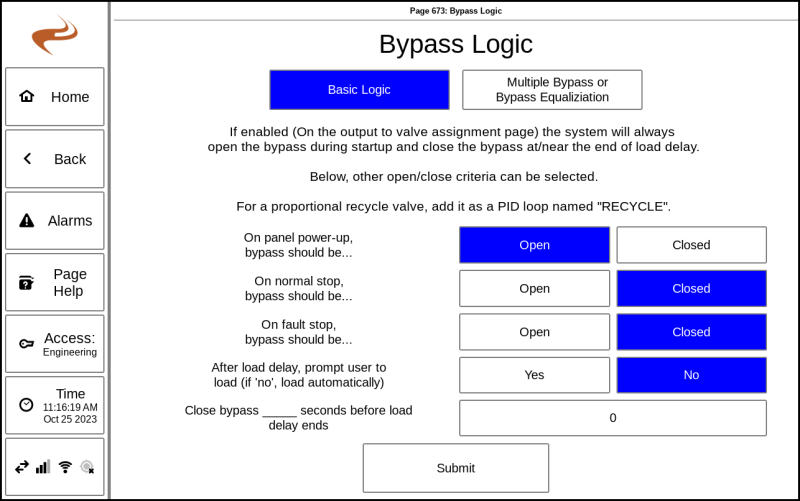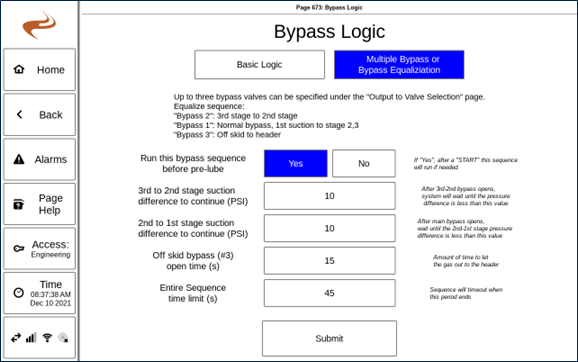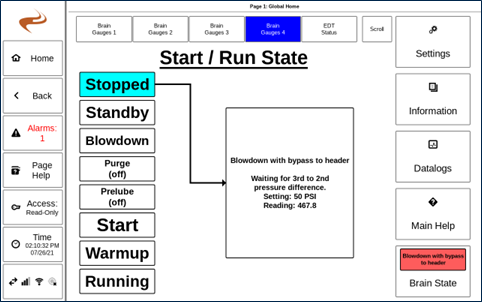Annunciator Bypass Setup: Difference between revisions
| Line 11: | Line 11: | ||
Once an output is assigned to run a bypass, in general the system will open the valve for startup and then close the valve when it is time to load the unit. The exact timings of both depend on a few other settings on the Bypass setup page under Brain -> Outputs Setup -> Bypass Logic. | Once an output is assigned to run a bypass, in general the system will open the valve for startup and then close the valve when it is time to load the unit. The exact timings of both depend on a few other settings on the Bypass setup page under Brain -> Outputs Setup -> Bypass Logic. | ||
[[File: | [[File:Bypass1b.png|800px]] | ||
Settings on this page: | Settings on this page: | ||
| Line 19: | Line 19: | ||
*'''On fault stop, bypass should be...''': Choose the state for the bypass after a fault shutdown | *'''On fault stop, bypass should be...''': Choose the state for the bypass after a fault shutdown | ||
*'''After load delay, prompt user to load''': If set to Yes, then after load delay a button appears in the corner telling the user the unit can be loaded. Selecting the button gives the option to close the bypass. If this setting is set to No, then the bypass will close automatically after load delay. | *'''After load delay, prompt user to load''': If set to Yes, then after load delay a button appears in the corner telling the user the unit can be loaded. Selecting the button gives the option to close the bypass. If this setting is set to No, then the bypass will close automatically after load delay. | ||
*'''Close bypass ____ seconds before load delay ends''': (This setting requires 1.63 or newer) Close the bypass before load delay ends. This can help give some times for pressures to settle before load delay expires. | |||
If the bypass is closed when the unit needs to be started then it will open during startup before pre-lube. | If the bypass is closed when the unit needs to be started then it will open during startup before pre-lube. | ||
Revision as of 17:18, 25 October 2023
Overview
A unit can be configured to have one or more bypass (on / off bypass) valves that are automatically actuated by the system.
Note that this is different from proportional recycle valves which can gradually recycle gas. For those types of valves see Dual Recycle Setup.
Basic Bypass Setup
To assign an output (and optionally feedback inputs) to use a normal Bypass valve, see Annunciator Valve Setup which talks about the output to valve assignment page. That page is also used to specify if the valve is powered to open or powered to close.
Once an output is assigned to run a bypass, in general the system will open the valve for startup and then close the valve when it is time to load the unit. The exact timings of both depend on a few other settings on the Bypass setup page under Brain -> Outputs Setup -> Bypass Logic.
Settings on this page:
- On panel power up, bypass should be...: Choose the state to have the bypass when the panel powers up
- On normal stop, bypass should be...: Choose the state for the bypass after a normal manual stop
- On fault stop, bypass should be...: Choose the state for the bypass after a fault shutdown
- After load delay, prompt user to load: If set to Yes, then after load delay a button appears in the corner telling the user the unit can be loaded. Selecting the button gives the option to close the bypass. If this setting is set to No, then the bypass will close automatically after load delay.
- Close bypass ____ seconds before load delay ends: (This setting requires 1.63 or newer) Close the bypass before load delay ends. This can help give some times for pressures to settle before load delay expires.
If the bypass is closed when the unit needs to be started then it will open during startup before pre-lube.
Note that if the bypass is set to close automatically after load delay (the last setting above is set to NO) then the process pressures should have low kills set to 'C' class to make sure the sequence doesn't fault out as the bypass is closing.
Multi bypass setup
The latest software versions for Dynamic Control panels added support to have multiple bypass valves on a panel that can be used for blowing down pressure from a unit to a header. This document describes how to use this feature.
The software versions required are the following or newer:
- DCT: 1.49.169
- Brain: 2200
Note: Earlier versions ran this sequence at shutdown, and was moved to startup with the above versions.
Specifying Inputs and Outputs
As mentioned in the basic bypass setup above, the Output to Valve Assignment page is used to specify which outputs and inputs are used for the bypass valves. There are three bypass valves that can be assigned:
- The first bypass "BYPASS" is from 1st suction to stage 2/3. This is the row used if there is only one bypass as well.
- The second bypass is for Stage 3 to 2.
- The last bypass is for an off-skid valve from the unit discharge to station header. It functions similar to a blowdown to release pressure from the unit, but to the header.
Not all three valves must be assigned- any combination can be used. Similarly, if valve feedback is not assigned then it will be ignored.
“Blowdown With Bypass” Sequence
By default, the multiple bypass valves will all operate in tandem in the same method as the single bypass operated previously. Alternately, a new staggered blowdown sequence can be configured under Settings -> Brain -> Outputs Setup -> Bypass Logic and going to the “Multiple Bypass” tab.
This sequence will happen on startup after ‘start’ press if the bypass valves are currently closed. If they are already open (for example, the previous start did not result in loading a unit) then the sequence is skipped. The general sequence is:
- Suction closed
- Bypass from 3rd->2nd stage (“Bypass #2”) opens (if present)
- System waits for the Discharge 3 – Suction 2 difference to be within a threshold
- Bypass from 1st suction to stage 2/3 opens (“Bypass”)
- System waits for the Suction 2 – Suction 1 difference to be within a threshold
- Bypass off-skid to station header is opened (“Bypass #3”)
- After a fixed delay, the off skid bypass is closed
If one of the bypass valves is not used then that step is skipped.
To use the sequence, set the first setting to “Yes” and specify the two pressure difference thresholds.
The last setting specifies the maximum amount of time the sequence should take, if this timer expires then an alarm is generated, and the valves go to the ESD state (see below). The sequence might get stuck, for example, if a valve fails to open.
The “Off skid bypass open time” specifies how long the off skid bypass will remain open to allow pressure out to the header. A larger unit or smaller pipe might require more time.
For any valve with a feedback assigned the system will always wait for the valve state to be confirmed before moving on with the sequence.
Note: After this sequence completes the next step will be the blowdown vent, which can still happen if the suction pressure is reading above the blowdown limit. If the pressure is below that limit then the sequence goes to pre-lube.
Sequence Status
If the run/start sequence gauge is turned on it will show the current step of the bypass sequence. This can also be seen by hitting the “Brain State” button on the home page.
ESD State
If the sequence fails, the valves will go to their alarm state.
Optionally the blowdown (vent) valve can open after an ESD shutdown. This can be specified at the Output Setups -> Blowdown. Using this feature requires a suction block valve to be in place.
If an automatic blowdown (vent) during startup is not desired, set the first setting for high blowdown limit to “0”. The vent after ESD can still be set to Yes in any case.
After clearing the alarm or hitting reset on the panel the blowdown (vent) valve will close if it was open.
Load Sequence
The addition of multiple bypass valves does not change the load sequence.
I.e., under Bypass Settings the system can be configured to prompt the user to load, in which case a button appears that allows the user to close the bypass valve(s). If this setting is off, then bypass valve(s) will close automatically at end of load delay.
Regardless of the state of the valves after shutdown all bypass valves will always open during the start sequence.


